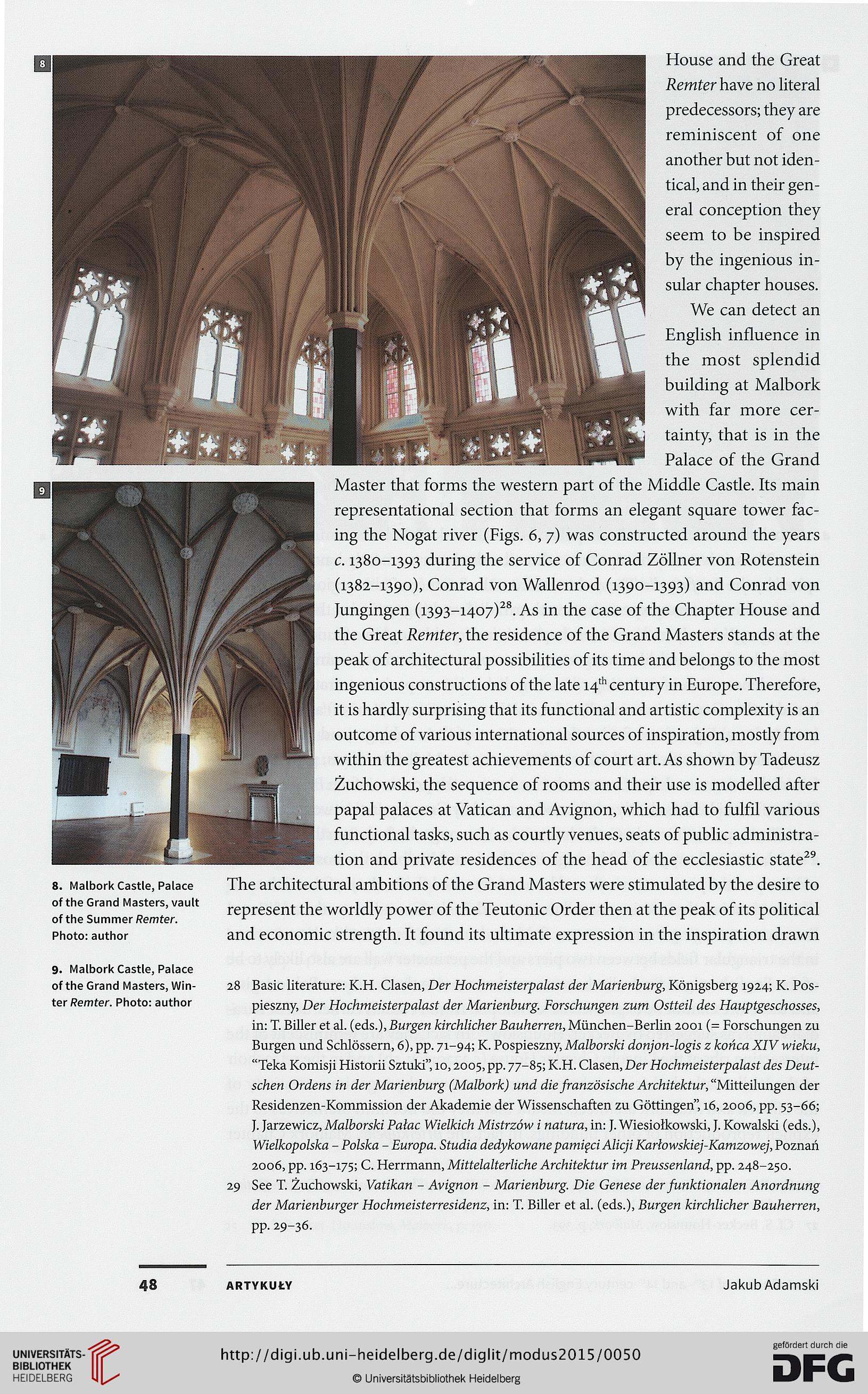8. MałborkCastte, Pałace
oftheGrand Masters, vautt
of the Summer Remfer.
Photo:author
House and the Great
Remfer have no literal
predecessors; they are
reminiscent of one
another but not iden-
tical, and in their gen-
eral conception they
seem to be inspired
by the ingenious in-
sular chapter houses.
We can detect an
English influence in
the most splendid
building at Malbork
with far more cer-
tainty, that is in the
Palace of the Grand
Master that forms the western part of the Middle Castle. Its main
representational section that forms an elegant square tower fac-
ing the Nogat river (Figs. 6, 7) was constructed around the years
c. 1380-1393 during the service of Conrad Zóllner von Rotenstein
(1382-1390), Conrad von Wallenrod (1390-1393) and Conrad von
fungingen (1393-1407)^. As in the case of the Chapter House and
the Great Remfer, the residence of the Grand Masters stands at the
peak of architectural possibilities of its time and belongs to the most
ingenious constructions of the late 14^ century in Europe. Therefore,
it is hardly surprising that its functional and artistic complexity is an
outcome of various international sources of inspiration, mostly from
within the greatest achievements of court art. As shown by Tadeusz
Żuchowski, the sequence of rooms and their use is modelled after
papal palaces at Vatican and Avignon, which had to fulfil various
functional tasks, such as courtly venues, seats of public administra-
tion and private residences of the head of the ecclesiastic stated
The architectural ambitions of the Grand Masters were stimulated by the desire to
represent the worldly power of the Teutonic Order then at the peak of its political
and economic strength. It found its ultimate expression in the inspiration drawn
9. MatborkCastte, Pałace
of the Grand Masters, Win-
ter Remfer. Photo: author
28 Basic literature: K.H. Clasen, Der Hochmeisferpninst der Marien Jury, Kdnigsberg 1924; K. Pos-
pieszny, Der PfocJmeisferpaiast Jer MarienJury. ForscJunyen żuru Ostteil des HaaptyescJosses,
in: T. Biller et al. (eds.), Buryen kirchiicJer BauJerren, Mtinchen-Berlin 2001 (= Forschungen zu
Burgen und Schlossern, 6), pp. 71-94; K. Pospieszny, MaiJorski donjon-ioyis z końca XJV wieku,
"Teka Komisji Historii Sztukil 10,2005, pp. 77-85; K.H. Clasen, Der HoHm?eisferpaia.sf des Deut-
schen Ordens in der MarienJury (Maldork) unJ Jie/rnnzbsiscde Architektur, "Mitteilungen der
Residenzen-Kommission der Akademie der Wissenschaften zu Gottingen" 16,2006, pp. 53-66;
j. Jarzewicz, MaiJorski Pałac Wielkich Mistrzów i natura, in: J. Wiesiołkowski, J. Kowalski (eds.).
Wielkopolska - Polska - Europa. Studia dedykowane pamięci Alicji Kariowskiej-Kamzowej, Poznań
2006, pp. 163-175; C. Herrmann, Mittelaiterlicke Architektur im Preussenland, pp. 248-250.
29 See T. Żuchowski, Vatikan - Aidyuon - MarienJury. Die Genese deryunktionalen Anordnuny
der MarienJuryer Hochmeisterresidenz, in: T. Biller et al. (eds.), Buryeu kirchiicher Bauherren,
pp. 29-36.
48
ARTYKUŁY
Jakub Adamski




